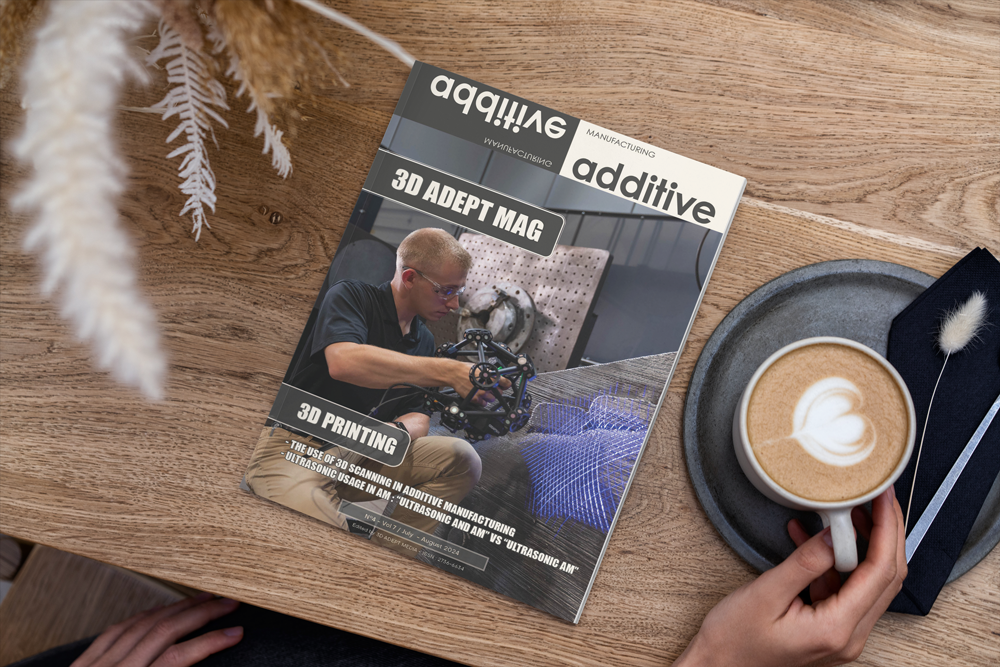Download the 2024 July/August edition of 3D ADEPT Mag
The more we witness new developments enabled by Additive Manufacturing (AM), the more our wording evolves. At this stage of the technology maturity, we, at 3D ADEPT Media, do not believe one should still qualify the technology as a “new” one. We should rather continuously assess what might come next in this field.
This summer edition of 3D ADEPT Mag sheds light on these solutions that are not yet on the top of companies’ agenda – they include for instance ultrasonic AM, design automation or even antimicrobial additives –. We provide insights into these applications that could help users make the most of AM in the mobility industry and a business perspective on the current landscape of certain emerging solutions such as AI.
As an echo to the current vibrant, dynamic and sunny days, this blend of timely themes can help both beginners and advanced users stay active and keep track of their progress in the industry.
Exclusive features
Metal AM | Ultrasonic usage in AM: “Ultrasonic and AM” vs “Ultrasonic AM”
Among the wide range of technologies or features that can be used to enhance production with AM, there is ultrasonic. Interestingly, we first discovered ultrasonic Additive Manufacturing as a manufacturing process, but the more we dive into the different usages of ultrasonic, the more we find out that the term can be applied to other applications. With contributions from Solukon’s Andreas Hartmann and Fabrisonic’s Mark Norfolk.
Post-processing | The use of 3D scanning in Additive Manufacturing
If you work in the engineering field, you are probably already familiar with 3D scanning, this process that consists in capturing a physical subject to represent its geometry in a digital environment. The 3D scan data captured can serve for visualization, analysis, or Additive Manufacturing. Creaform’s Simon Côté and Nikon’s Kristof Peeters on the essentials one should keep in mind when using 3D scanning in an Additive Manufacturing production process.
Q&A | BMF on the current state of the micro 3D printing market and where it is headed for.
To understand why the micro 3D printing niche is on a steady path, we asked John Kawola, CEO of Boston Micro Fabrication (BMF) a few technical questions.
Software | Areas where design automation for Additive Manufacturing makes sense.
The more complex the part is, the more it requires several CAD tools which designers do not necessarily have expertise in. Not to mention that every AM process comes with its challenges or constraints that need to be considered during the manufacturing process. Given these considerations, automating the design of AM parts during the DfAM process is a legitimate path to explore but the framework surrounding this process is yet to be mastered. With insights from Diabatix’ Dr. Ir. Lieven Vervecken.
AM Shapers | Behind the scenes of Ford’s AM journey in Europe.
When the “number of 3D printers you have does not tell the full story.” A conversation with ,” Rene Wolf, Managing Director of Manufacturing at Ford-Werke.
Exclusive Insight | Extreme bike tuner steers into the future with 3D printing
Extreme bike tuner Dangerholm makes science fiction rideable. His idea of the bike of the future poses challenges for manufacturers. But together with TRUMPF and the TruPrint metal 3D printers, a prototype was ready to ride at Eurobike 2024.
FOCUS | How Evonik’s use of LCA helps deliver a strong sustainable INFINAM® eCO line for the AM industry
While decisions that influence each circular economy strategy vary from one company to another, they need to start with life cycle assessments (LCAs). Interestingly, it takes a conversation with Evonik to understand the perspective of a material producer on LCAs and how this has driven the development of the INFINAM® eCO line.
Materials | Antimicrobial Additives in 3D printing filaments: Transforming industries through hygiene solutions
In industries where hygiene is paramount, such as healthcare, food processing, and aerospace, the incorporation of antimicrobial additives into 3D printing filaments has become pivotal. These additives inhibit the growth of microorganisms on printed surfaces, ensuring a cleaner and more hygienic environment for end-users. This article from Addmaster explains the use of antimicrobial additives in 3D printing filaments, exploring their significance, mechanisms, and industry-specific applications.
Business | When European manufacturers are optimistic about AI but struggle with implementation
The 2024 AI in European Manufacturing Report sheds light on the current adoption rates, benefits, and future expectations of artificial intelligence (AI) in manufacturing. The report reveals that most European manufacturers have high hopes for AI, but fail to implement the technology.
Events
EPMA releases EURO PM2024 congress & exhibition technical program
RAPID+TCT 2024: Hollywood meets Additive Manufacturing



